GeIL Evo Veloce Review: 2x8GB at DDR3-2400 C11-12-12 1.65 V
by Ian Cutress on October 24, 2012 5:50 PM EST- Posted in
- Memory
- Ivy Bridge
- DDR3
- GeIL
USB 3.0 Backup
Our backup testing takes a typical set of user files – specifically just under 8000 files across 7.5 GB, some large files but mostly small. For USB 3.0 testing, these files are copied from our SSD onto an OCZ Vertex3 which is connected via a SATA 6 Gbps to USB 3.0 device using the UASP protocol that the ASMedia controller on our test bed affords as well as the chipset driven Intel USB 3.0 under ASUS' Turbo mode. The copy test is conducted using DiskBench, a copying tool with accurate copy timing.
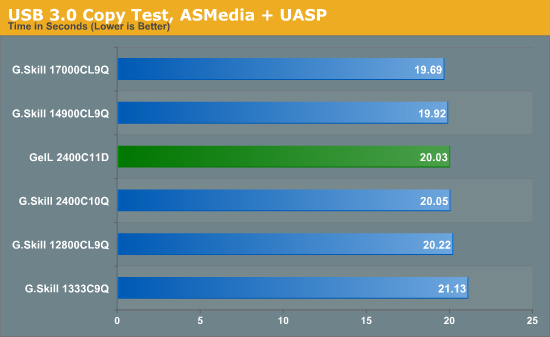
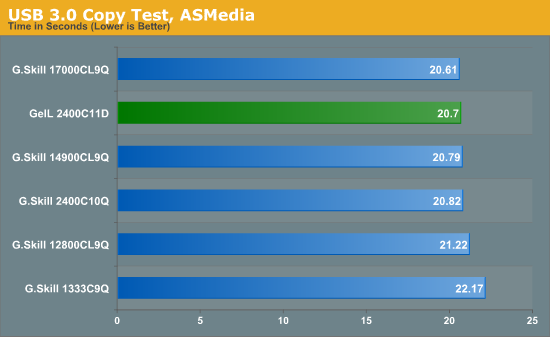
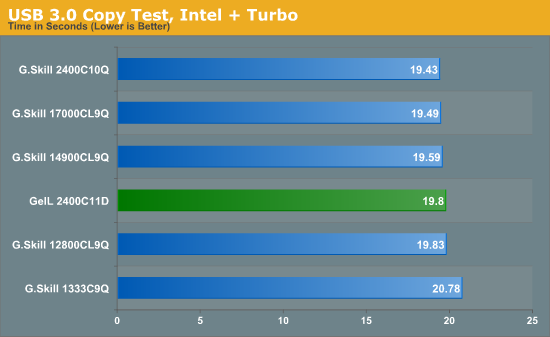
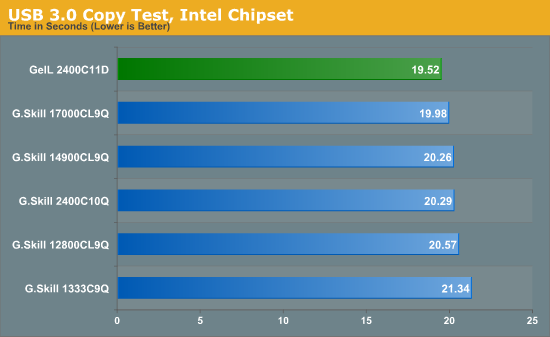
In the USB 3.0 testing, we find some interesting results:
USB 3.0 ASMedia + UASP: 2400 C11 is between 1600 C9 and 1866 C9
USB 3.0 ASMedia: 2400 C11 is between 1866 C9 and 2133 C9
USB 3.0 Intel + Turbo: 2400 C11 performs similar to 1600 C9
USB 3.0 Intel: 2x8 GB 2400 C11 is better than 4x4 GB 2400 C10
In most motherboards, the USB 3.0 Intel result will be the main point of the test (ASMedia and UASP are limited to ASUS at the minute), and it seems the Intel chipset likes denser modules for USB 3.0 testing.
Thunderbolt Backup
Similar to our USB 3.0 Backup test, Thunderbolt testing carries the same files directly through to our LittleBig Disk which contains two 120 GB Intel SSDs in RAID-0. The copy test is conducted using DiskBench, a copying tool with accurate copy timing.
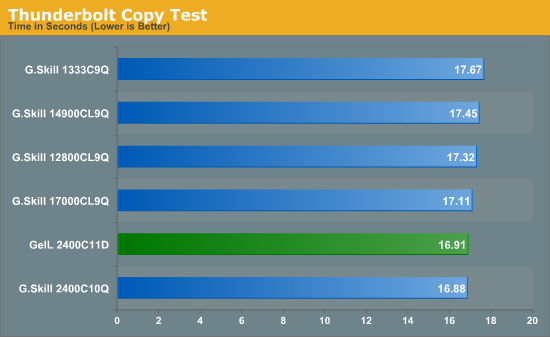
Our 2400 C11 kit performs similar to the 2400 C10 and better than the 2133 C9, meaning that Thunderbolt is a big fan of memory MHz.










30 Comments
View All Comments
Beenthere - Wednesday, October 24, 2012 - link
Can't change the type from 8166 MHz. to the proper 1866 MHz. but most folks should be able to figure it out...silverblue - Thursday, October 25, 2012 - link
Of course, if you have an APU-based system, the faster memory does indeed make a difference... though I agree, it's the exception rather than the norm.JlHADJOE - Thursday, October 25, 2012 - link
But then its totally contrary to one of the main reasons behind having an APU -- penny pinching.These kits cost twice the DDR3-1333 going rate, so that's $75 you could have put into a GPU. Can't speak for everyone, but I'd probably choose an i3 with DDR3-1333 + a 7750 over an A10-5800k with DDR3-2400.
JohnMD1022 - Wednesday, October 24, 2012 - link
My thoughts exactly.1600 seems to be the sweet spot on price and performance.
PseudoKnight - Wednesday, October 24, 2012 - link
Anandtech did a series of memory frequency tests like a year ago (I forget exactly). While they found that 1333 to 1600 didn't offer much in terms of average FPS gains in gaming, it had a clearer impact on minimum frame rates. I'm not saying it's worth it either way here, but I'd like people to give some attention to minimum frame rates when talking about the benefits of bumps in memory frequency.That said, 2400 is obviously overkill here, but that should be obvious to anyone who wants to spend their money efficiently.
Impulses - Thursday, October 25, 2012 - link
The article the did a year ago (with Sandy Bridge in mind) says absolutely nothing about minimum frame rates vs average... I don't even see how faster memory could have such an effect with a dedicated GPU.Impulses - Thursday, October 25, 2012 - link
*theyJlHADJOE - Thursday, October 25, 2012 - link
It might have been techreport. They're the guys who usually do those frame-time measurements.poohbear - Thursday, October 25, 2012 - link
pseudoking what are u talking about? there is virtually NO effect on minimum frames on a dedicated GPU system. Ever since the memory controller moved to the CPU, the RAM timings have become ALOT a less important component in the system. The only way it shows a difference is when you go to all kinds of outlandish scenerios that involve isolating the GPU and CPU to situations that show some difference between RAM, but in a real world setting those situations are so rare that it becomes pointless to even entertain them.Ratman6161 - Thursday, October 25, 2012 - link
But add running virtual machines to your list of reasons why a lot of memory might be good. When working from home I've actually typically got the host machine where I'm doing most of my actual work plus at least two virtual machines running, each VPN'ed into a different remote network. So it isn't too uncommon for me to see about 90% of my 16 gb in use at any one time. And I do occasionally hit times when I have to shut down one VM in order to start another. So I wouldn't actually mind having 32 GB.On the other hand, while I need a large quantity of RAM, my 1600 MHz G-Skill works just fine performance wise so I don't need speed - I need quantity.